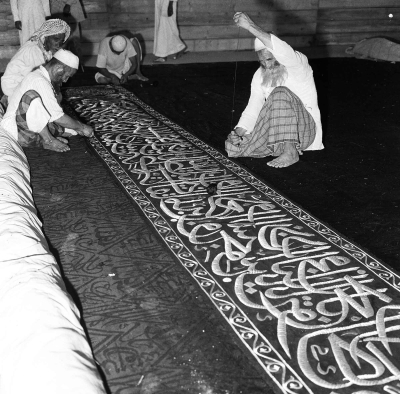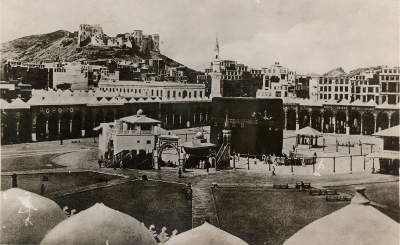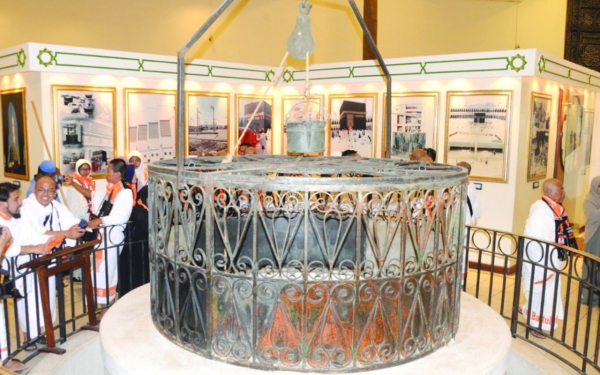
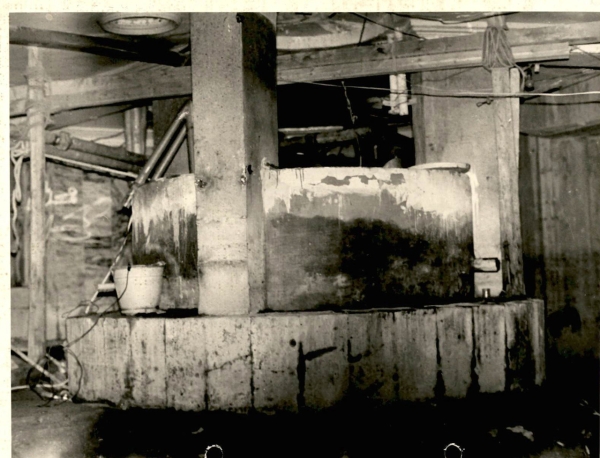
Zamzam Well is a well located in the Grand Mosque in Makkah al-Mukarramah, near al-Kaaba al-Musharrafa. It is the source of Zamzam water, which the Prophet Muhammad, peace be upon him (PBUH), described as blessed water and stated that it is a cure for diseases.
Location of Zamzam Well
Zamzam Well is located within the Mataf area in the Grand Mosque in Makkah al-Mukarramah, west of the Kingdom. It is positioned on the eastern side of al-Kaaba al-Musharrafa, approximately twenty-one m away, and aligns with al-Multazam. Al-Azraqi described Zamzam Well in his time as 'the depth of Zamzam from top to bottom was sixty cubits, and at its bottom, there were three springs: one spring next to the Black Corner, another spring next to Abu Qubais and as-Safa, and a third spring next to al-Marwah.'
Ibrahim Rifaat Pasha described it during his time (which was the early twentieth century). He noted that Zamzam Well is located south of the Station of Ibrahim, and mentioned that the northwest corner of the structure above Zamzam Well aligns with the Black Stone and is eighteen m away from it. He described the structure over the well as square-shaped from the inside with each side measuring 5.25 m, paved with marble. The structure consists of two levels: the first for servicing the well, and the second for the service of the eunuchs (Aghawat), and those wishing to bathe would ascend via a wooden staircase.
Zamzam names
The name Zamzam originates from Hajar, the mother of Ismail. When the water from the well began to gush forth, she started to gather the water while saying "Zummi, Zummi."
Ibn Bari, as quoted by Ibn Manzoor, the author of Lisan al-Arab, mentioned several names that are used to refer to Zamzam. These names include: Rakdat Jibril, Hazmat Jibril, Hafirah Abd al-Muttalib, Madhnoonah, Maktumah, Suqiya al-Rawaa, Shuba'ah, Shifa' Suqm, and Ta'am Tu'am.
Yaqut al-Hamawi, the author of Mu'jam al-Buldan, listed several names derived from the name Zamzam, which Muslims use to refer to both the well and the water, indicating their significance. As he mentioned, these include: Zamam, Zuzum, and Zumazim. Additionally, names derived from events associated with the well include: Hazmat Jibril,Rakdat Jibrail, Hazmat al-Malak, both Hazma and Rakda, which mean a depression in the ground. The term Hazma also refers to a foot pressed into the ground by the heel. Furthermore, Zamzam is also known as: Sqiya Allah li Ismail (God's water provision to Ismail), Shuba'ah (with or without the definite article "al"), Madhnoonah, Barrah, Taktum, Ta'am Tu'am, Shifa' Suqm, Ta'am al-Abrar, Sharab al-Abrar, and Teebah.
Zamzal Well significance
Zamzam Well holds a spiritual and symbolic significance for Muslims and is considered one of the important landmarks in the Grand Mosque, alongside other existing features. Over time, Muslims have developed a strong connection to Zamzam Well, which has become a destination for Muslims performing the rituals of Hajj and Umrah.
The origins of Zamzam are linked to the Prophet Ibrahim (PBUH), his wife, and his son. The water of Zamzam sprang forth in front of the infant (at that time) Prophet of Allah, Ismail (PBUH), and his mother, Lady Hajar, the wife of Khalil Allah (Friend of Allah) Ibrahim (PBUH). Ibrahim had settled his offspring in a barren valley near the sacred house of Allah.
Zamzam water benefits
Muslims regard the water produced by Zamzam Well as both sustenance and a healing remedy for ailments, believing it to have sprung forth by the command of Allah.
Imam Muslim narrates in his Sahih that the companion Abu Dharr al-Ghifari, may Allah be pleased with him, when he came to Makkah and entered the Haram, stayed there for thirty days. The Prophet Muhammad (PBUH) asked him, "How long have you been here?" Abu Dharr replied, "I have been here for thirty days and nights." The Prophet Muhammad (PBUH) then asked him, "Who has been feeding you?" Abu Dharr said, "I had no food but the water of Zamzam, and I became so fat that my belly swelled. I did not feel any weakness from hunger." The Prophet Muhammad (PBUH) responded, "Indeed, it is blessed; it is nourishing food." Ibn al-Qayyim mentions in his book Zad al-Ma'ad about the benefits of Zamzam water, "I have seen those who subsist on it—Zamzam water—for several days, nearly half a month or more, without feeling hunger. They perform Tawaf with the people just like anyone else, and one informed me that he sometimes relied on it for up to forty days."
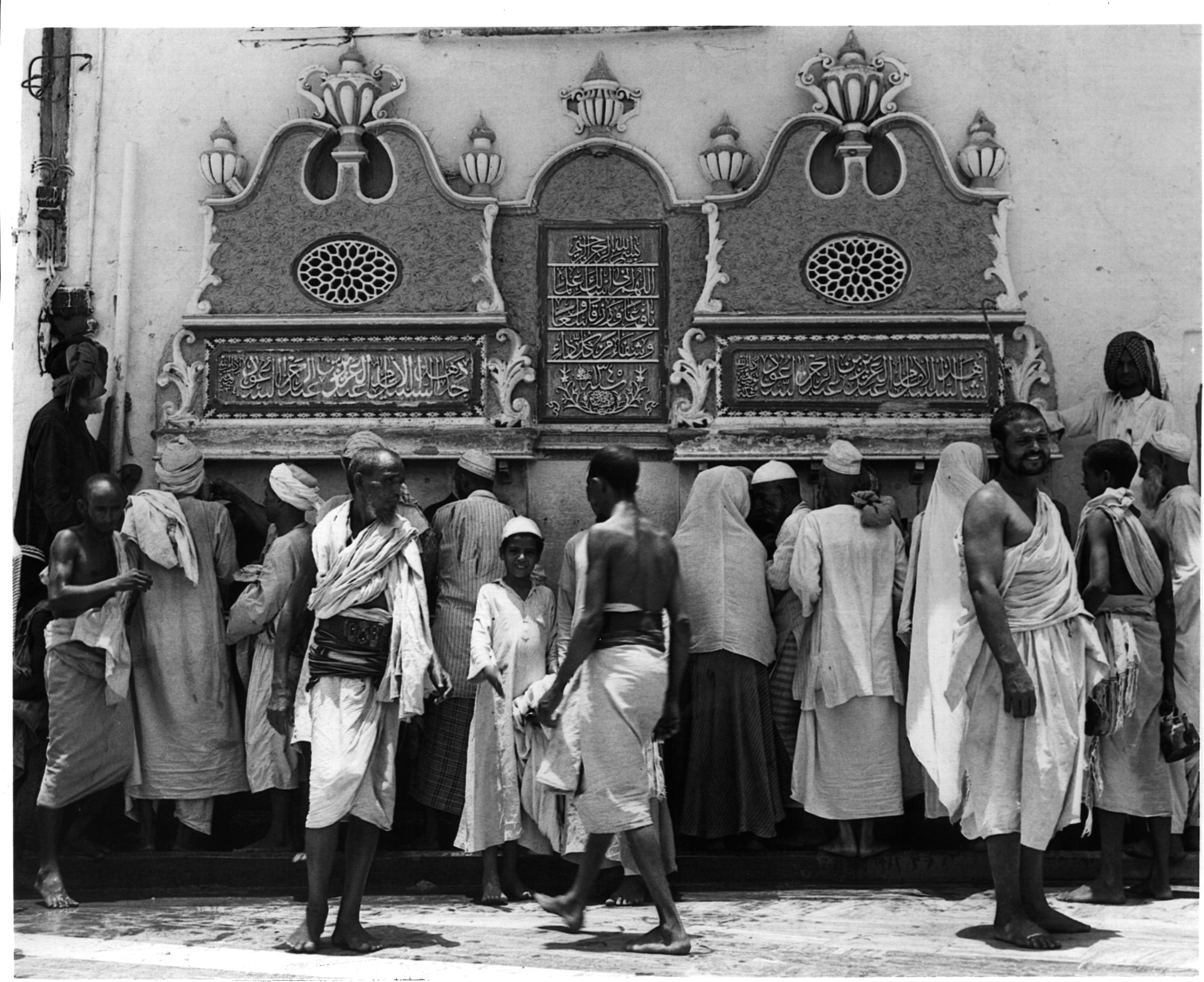
History of Zamzam
Zamzam Well before Islam
The origins of Zamzam Well and its initial surge of water, as narrated by Islamic sources, trace back to the migration of Prophet Ibrahim, Hajar, and their son Ismail to al-Kaaba al-Musharrafa in Makkah al-Mukarramah. Prophet Ibrahim left Hajar and her infant son near a tree above the site where Zamzam would later emerge (though the well was not yet in existence). He provided Hajar with a leather bag containing some dates and a water-skin containing water. At that time, Makkah al-Mukarramah was uninhabited and barren. As Prophet Ibrahim set to leave and return, Hajar, the mother of Ismail, followed him and asked, "Where are you going, Ibrahim, leaving us alone in this valley where there is no one else of humankind or jinn?" Ibrahim did not respond to her and did not turn back, even as she repeated her question several times. When Ibrahim still did not answer, she asked him, "Has Allah commanded you to do this?" At that point, Ibrahim (PBUH) answered her, "Yes." She then said, "Then He will not neglect us." After that, she returned to the place where Ibrahim had left her. As for Prophet Ibrahim, he proceeded to where he intended to go until he reached the Thaniya where they could not see him. He then faced al-Kaaba and raised his hands, supplicating to God as mentioned in the noble verse, "Our Lord, I have made some of my offspring to dwell in an uncultivable valley by Your Sacred House." (Ibrahim: 37). Hajar, the mother of Ismail, continued to breastfeed her son and drank from the water that Prophet Ibrahim had left for them until it ran out, causing them both to become thirsty. As her son writhed in thirst, she set out in search of water. She found Safa, the nearest mountain to her, climbed it, and scanned the valley hoping to see someone, but she saw no one. Then she descended from Safa and, upon reaching the valley, lifted the hem of her garment and ran with all the exhaustion of a desperate person, crossing the valley to reach Marwah. Upon climbing Marwah, she looked again for anyone in sight but saw no one. Hajar did this seven times. On her final approach to Marwah, she heard a sound and said, 'Shshs!' and listened attentively. She heard the voice again and said: 'O (whoever you may be), you have made me hear your voice; have you any succor for me?' And behold! She saw an angel at the place of Zamzam, digging the earth with his heel (or with his wing), till water flowed out from that place. She started to make something like a basin around it and began to fill her water-skin with water with her hands, and the water was flowing out until she had scooped some of it. Then she drank (water) and suckled her child. The angel said to her: 'Do not be afraid of being neglected, for this is the site on which the House of Allah will be built by this boy and his father, and Allah will never let neglected His people.'
Hajar remained in that state, utilizing the water from Zamzam and breastfeeding her young child. Then, a group from the Jurhum tribe passed by to the lower part of Makkah. They saw a bird circling the area and, with the acuteness typical of desert dwellers, deduced that there must be water there. They had passed by this place before and it had been without water, so they sent messengers to verify the situation. Upon discovering the water, they returned to their people to share the news. The Jurhum group approached where Hajar and Ismail were near the water. They asked her permission to settle with her, to which she agreed but made it clear that they had no right to possess the water. They accepted her terms.
Zamzam Well with the Quraysh
After the time of Prophet Ibrahim (PBUH) the Zamzam Well dried up and its features were obscured until Abd al-Muttalib, the grandfather of Prophet Muhammad (PBUH), re-excavated it, allowing its water to flow once again, continuing to this day.
During the time of the Quraysh, Zamzam was not a flowing spring. This is supported by a narration about Zamzam related by Ali Ibn Abi Talib, may Allah be pleased with him, who said, "When Abd al-Muttalib was asleep near al-Kaaba, he saw a dream that asked him to: 'Dig Barrah.' He asked, 'What is Barrah?' The dream stopped there. The next day, he slept in the same place and was asked, "Dig Madhnoonah." He asked, "What is Madhnoonah?" Then the dream stopped again. The following day, he returned and slept in the same spot. He was visited once more in his dream and was asked, "Dig Teebah." He asked, "What is Teebah?" Then the dream stopped again. The next day, he returned and slept in the same place. He was visited again and was asked, "Dig Zamzam." He asked, "What is Zamzam?" The answer was, "It will never dry nor fail to water," and then its location was described to him. Abd al-Muttalib then began to dig where it was indicated to him. The Quraysh saw him and asked, "What is this, O Abd al-Muttalib?" He said, "I have been commanded to dig Zamzam." When it was uncovered and they saw the spring, they said, "O Abd al-Muttalib, we have a right in it with you. It is the well of our father Ismail." He said, "‘I was specially told of it and not you, and I was the one to be given it." They said, "Do us justice." He said, "Yes." They said, "Our dispute shall be resolved by a woman diviner of the Banu Saad Bin Hudhaym, who dwelt the uplands of Sham. He said: Abd al-Muttalib accompanied by some of his relations and a representative from all the tribes of Quraysh, rode away. They went on through a desolate country between the Hejaz and Sham until Abd al-Muttalib’s company ran out of water and they feared that they would die of thirst. They asked the tribes to give them water, but they refused, on the ground that if they gave them their water they too would die of thirst. Abd al-Muttalib then said to his companions, "What should be done?" They said, "We see no option but to follow your instructions."Abd al-Muttalib then said, "I think that every man should dig a hole for himself with the strength that he has left so that whenever a man dies his companions can thrust him into the hole and bury him until the last man, for it is better that one man should lie unburied than a whole company." So, they did. Then he said, "By Allah, to abandon ourselves to death in this way and not to scour the country in search of water is sheer incompetence; perhaps Allah will give us water somewhere." He then said to his companions, "Let's set off," and so they did. He went to his camel and mounted her and when she got up from her knees a flow of fresh water broke out from beneath her feet. Abd al-Muttalib and his companions dismounted and drank and filled their water skins. Then they invited the tribes to come to the water which Allah had given them and to drink freely. After they had done so and filled their water skins they said: ‘By Allah, the judgment has been given in your favor Abd al-Muttalib. We will never dispute your claim to Zamzam. He who has given you water in this wilderness is He who has given you Zamzam.’ Thus, Allah caused the well to flow at the hands of Abd al-Muttalib.
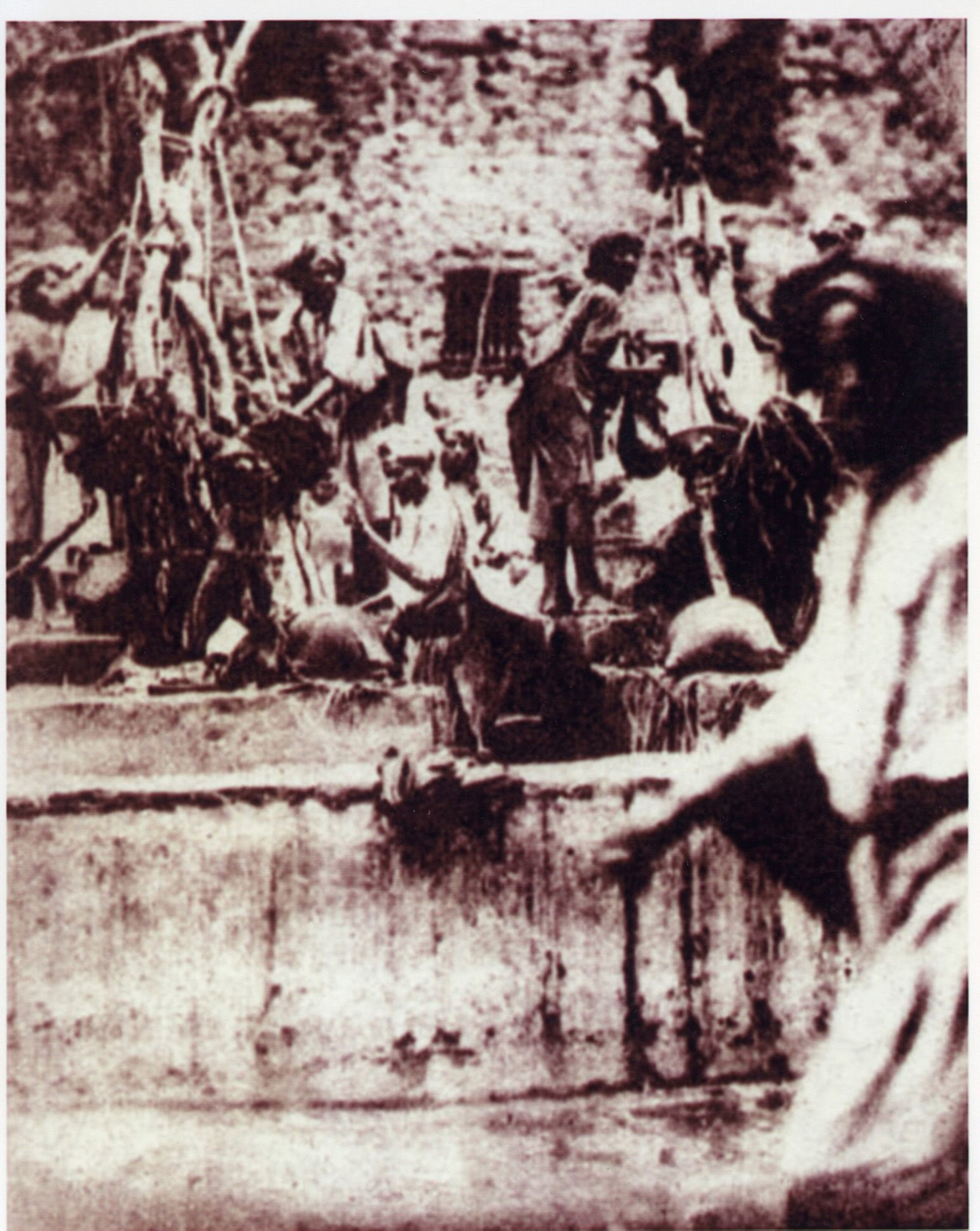
Zamzam Well after Islam
Abd al-Muttalib dug the well of Zamzam, and Allah caused its water to flow through his efforts. The features of the well became apparent, and he was given exclusive responsibility for its care over other tribes of Quraysh. The privilege of providing water (Siqaya) was granted to him and his descendants. Afterward, Zamzam well received continuous care throughout the Islamic eras. Abu Jaafar al-Mansur, during the Abbasid era, was the first to build with marble around the well, cover its top with a marble lid, and also pave its ground with marble. Later, it was renovated by al-Mahdi during the years of his caliphate.
During the caliphate of al-Mu'tasim in the year 645, Omar Ibn Faraj al-Rukhji made changes to the structure of the Zamzam Well, which was uncovered before his modifications but had a small dome over the well's location. There was a structure known as a "kanisah" at the corner near Safa on the left side, which in the language of the time referred to a structure resembling a howdah used for shade. This kanisah was located at the spot where the companion Ibn Abbas, may Allah be pleased with them, used to sit. Omar Ibn Faraj replaced the kanisah and covered the entire Zamzam with teak wood gilded from the inside. The exterior was decorated with mosaics. He also added a small annex to the Zamzam Well, in which he placed chains holding lanterns. Furthermore, Omar Ibn Faraj decorated the dome with mosaics between the Zamzam Well and the drinking area, enhancing the well's aesthetics for each season.
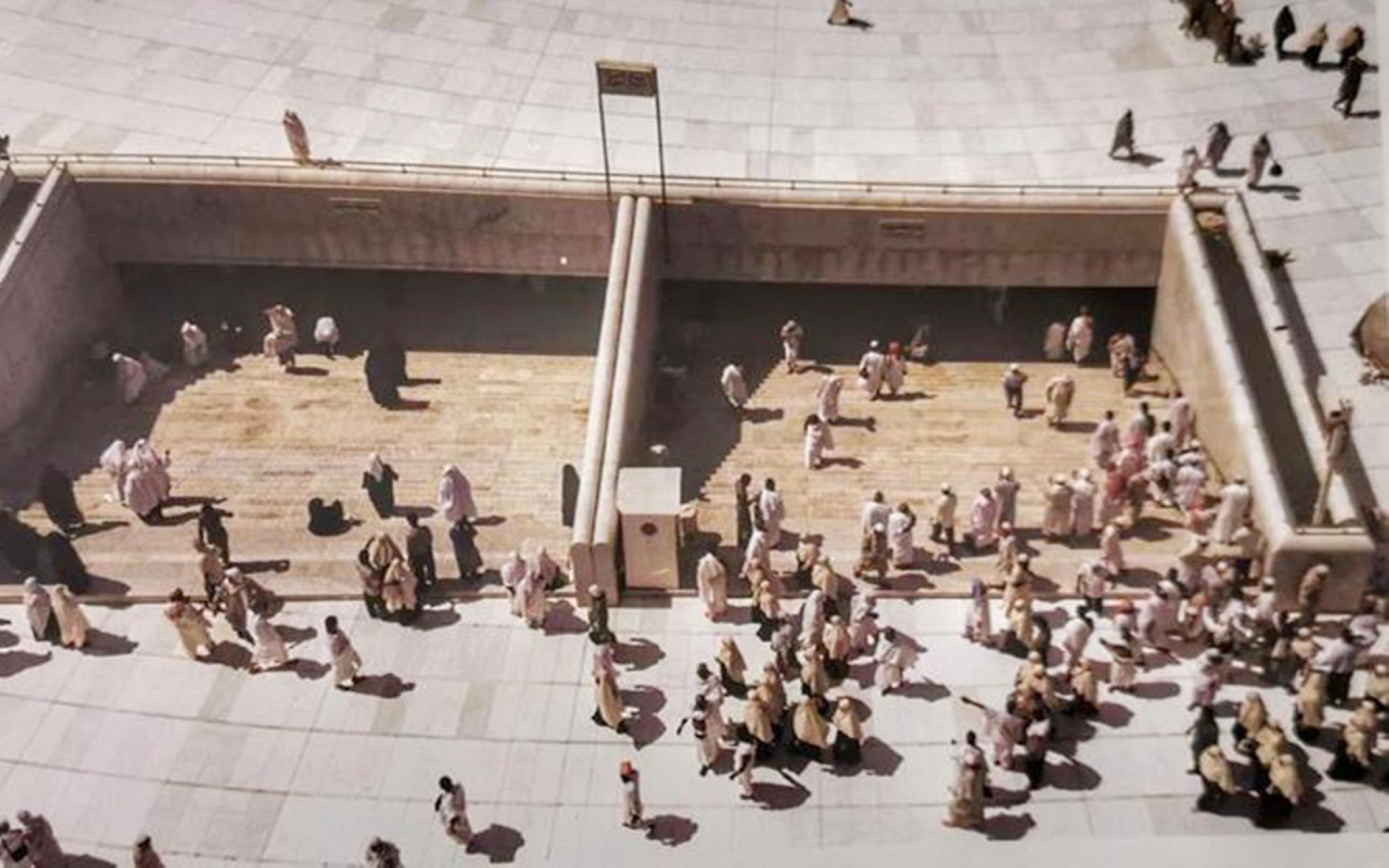
Zamzam Well in the Saudi era
Reign of King Abdulaziz
People used to drink from Zamzam using buckets until King Abdulaziz Bin Abdulrahman Al Saud ordered the installation of a pump in the Zamzam Well in 1953. The pump lifted Zamzam water to two upper tanks made of zinc, and twenty-four taps were installed on these tanks, with twelve taps for each tank. These taps were distributed around the well. It was also still possible to use buckets alongside the taps according to preference. All buildings that had been constructed over the Zamzam Well were removed.
In addition to establishing pumps for elevating Zamzam water, King Abdulaziz also created two public drinking fountains for Zamzam water. In 1926, he ordered the construction of a public fountain for dispensing Zamzam water, which was named Sabil al-Malik (the King's Fountain). The following year, he ordered the construction of another fountain. In the same year, he issued a command for the repair and cleaning of the well and ordered that a cover be placed over it.
Reign of King Saud
During the reign of King Saud Bin Abdulaziz Al Saud, people permanently stopped using buckets to draw water from Zamzam. In 1962, he issued a Royal Order to expand the Mataf, and as a result of this expansion, the opening of the Zamzam Well was lowered below the Mataf level, into a basement 2.7 m deep. This basement was divided into two sections, one for men and the other for women. One of the outcomes of the Mataf expansion was the elimination of the bucket phase entirely, as Zamzam water was no longer drawn using buckets but was instead accessed through faucets. The well was further developed, and the expansion of the Mataf was completed in 1963.
Reign of King Faisal
King Faisal Bin Abdulaziz Al Saud showed great concern for the Zamzam Well. In addition to the basement created during the Mataf expansion under King Saud's reign, King Faisal ordered the construction of an additional basement for the Zamzam Well in 1973. This initiative was part of his commitment to facilitate the pilgrims' convenience and provide them comfort during their rituals.
Reign of King Khalid
King Khalid Bin Abdulaziz Al Saud focused on maximizing the production of the Zamzam Well. He issued an order in 1979 to clean the Zamzam Well using the latest available methods and technologies at that time. Divers with expertise and experience in diving were employed for this task. The cleaning process was completed, leading to an increase in the well's water output. Consequently, the spring within the well was filled with more water than it had before the cleaning.
Reign of King Fahd
During the second phase of the Saudi expansion of the Grand Mosque under the rule of King Fahd Bin Abdulaziz Al Saud, a new water system for drinking and drainage was included. This system consists of two units: the first is a large pump for Zamzam water with drinking faucets, and the second is for the second floor of the expansion.
In 2003, studies related to the Grand Mosque highlighted the need to cover the entrances to the Zamzam Well basement to maximize the utility of the Mataf area and facilitate movement for Hajj and Umrah performers during crowded periods. The entrances to the basement leading to the well were roofed, and the drinking fountains were relocated to the sides of the Mataf area. These changes resulted in an increase of four hundred m in the Mataf area.
Reign of King Abdullah
King Abdullah Bin Abdulaziz Al Saud directed the establishment of a water purification station for the Zamzam Well, along with a facility equipped for bottling and transporting Zamzam water. The station operates with an automated system for control, monitoring, and storage. The project was named the King Abdullah Bin Abdulaziz Project for Zamzam Water Distribution. He also ordered the launch of two projects: the first focuses on the automated cleaning of Zamzam water containers, and the second aims to redesign these containers to protect the water, ensure its flow, and facilitate access to it.
The productivity of the project reaches up to two hundred thousand bottles per day, and the King Abdullah Bin Abdulaziz Project operates around the clock, twenty-four hours a day. It aims to provide service to Hajj pilgrims, Umrah performers, and those visiting the Grand Mosque, facilitating access to the blessed Zamzam water for its drinkers in a healthy and safe manner.
Reign of King Salman
In 2018, the Custodian of the Two Holy Mosques, King Salman Bin Abdulaziz Al Saud, directed the resumption of work on projects related to the Zamzam Well. He also instructed the completion of the project for special service ferries for the Zamzam Well, which include five ferries with various tasks. Additionally, he ordered the completion of the final phase of sterilization, impurity removal, and environmental inspection around the well.
Saudi Arabia's scientific efforts to develop the Zamzam Well
The Zamzam Studies and Research Center
The Kingdom has established a research center for the Zamzam Well, named "Zamzam Studies and Research Center," overseen by the Saudi Geological Survey. The center aims to identify and monitor water sources and to implement scientific solutions for preserving groundwater reserves and the Zamzam Well.
According to studies and research, Zamzam water is alkaline and rich in minerals beneficial to the human body. It also has antioxidant properties, acts as a potent detoxifier, and aids in the absorption of nutrients within the body.
Mandates of the Zamzam Studies and Research Center
The mandates of the center include comprehensive oversight of the extraction of Zamzam water, as well as the sterilization and storage processes. The center is responsible for preserving Zamzam water through a program that monitors the quantity and quality of the well's water. It oversees all filtration, sterilization, and storage operations in Makkah al-Mukarramah and al-Madinah al-Munawwarah, determining the appropriate and safe monthly and annual pumping volumes from the well based on modern methods. These quantities are updated annually, and the center ensures that the well's pumping aligns with the proposed volumes.
The need for the Zamzam Studies and Research Center
The need to establish the Zamzam Studies and Research Center arose due to the significant status the well holds among Muslims, attributed to its miraculous origin and its blessed water. With the challenges posed by urban activities and their connection to the economic and social development of Makkah al-Mukarramah City, the Kingdom established a specialized center. This center is dedicated to the care and preservation of the water sources of the Zamzam Well and the surrounding areas. It focuses on studies and research, applying modern scientific and technical methods.
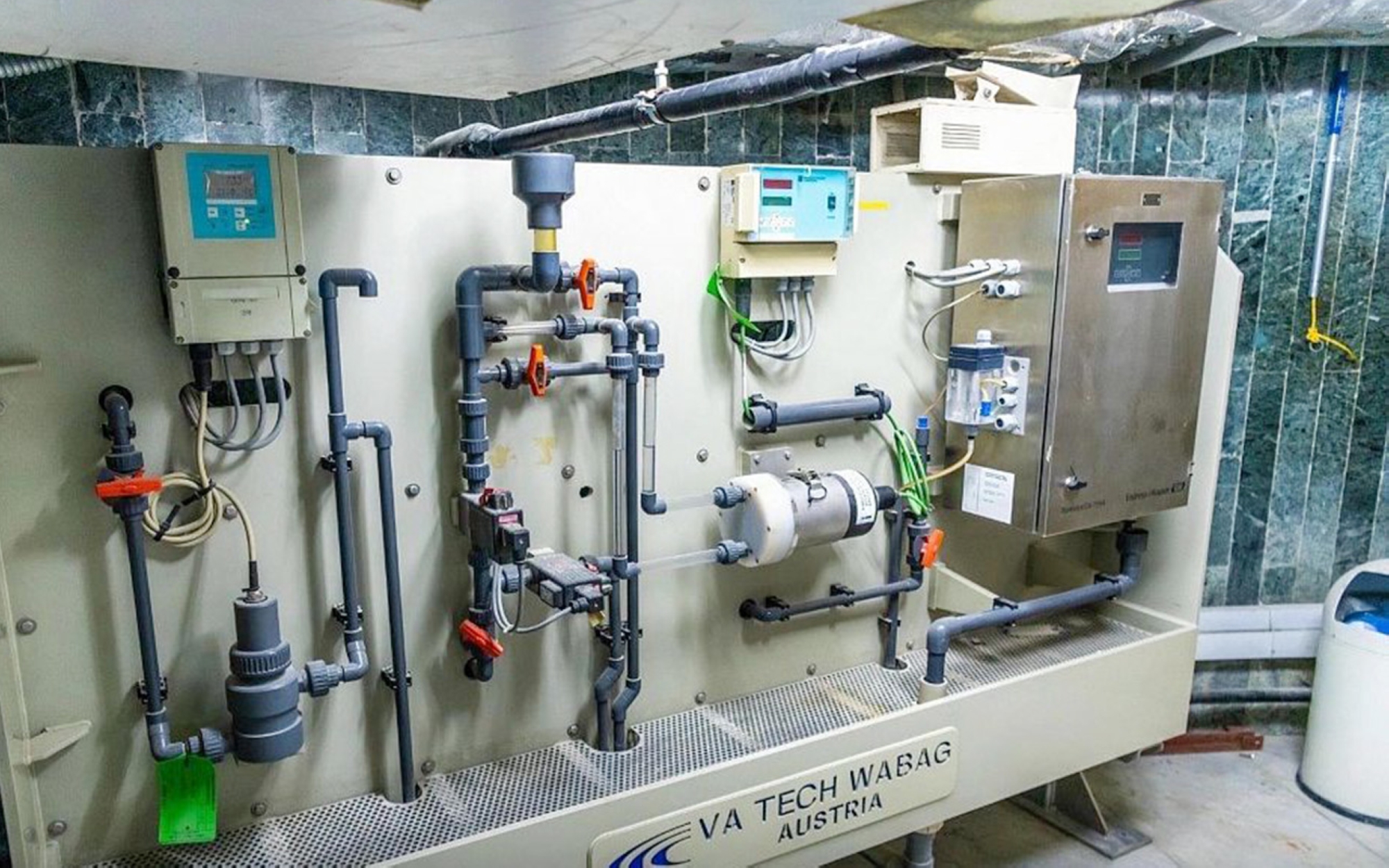
Sterilization of Zamzam Well water
Zamzam water is sterilized using ultraviolet radiation to destroy the DNA of germs and viruses without adding any chemicals. The sterilization level for bacteria and viruses reaches 99.77 percent. One KW of electricity can sterilize twelve thousand gallons of water, without altering the water's color, taste, or smell.
Zamzam water sterilization procedures
Ultraviolet radiation is used for sterilization by directing light energy produced by low-pressure mercury lamps protected by special glass, which allows the light to pass through and target bacteria, viruses, and microorganisms. This light penetrates their outer shells and destroys their DNA. The water is then passed through a cylindrical tube containing the lamps that generate the ultraviolet radiation. The number of lamps inside the cylinder depends on the cylinder's size and the amount of water to be sterilized. The speed at which the water enters the system is adjusted to ensure it is sufficient to kill the bacteria and viruses.
The General Presidency for the Affairs of the Grand Mosque and the Prophet's Mosque implements several measures to sterilize Zamzam water. These include pumping the water from the Zamzam well in a closed circuit, where the water passes through filters that trap impurities and sand. The water then flows through stainless steel pipes to reach sealed tanks and passes through initial sterilization devices. A team of specialists oversees the process to ensure that the operations are conducted according to established technical procedures.
Zamzam well productivity
Zamzam well pumping
Zamzam Well pumps a minimum rate of eleven L per second and a maximum of 18.5 L per second. The well itself is approximately thirty m deep. It is equipped with two giant pumps, each capable of handling 360 m per hour. These pumps operate alternately to extract Zamzam water from the well and pump it to the King Abdullah Zamzam Water Project. The water is transported through four km of stainless steel pipes, which are specifically designed to prevent corrosion and preserve the water’s unique properties.
Zamzam Well supplies water to the corridors of the Grand Mosque and delivers 150,000 L of its water daily to the Prophet's Mosque on regular days. During religious seasons, this amount increases to four hundred thousand L per day. The operations of water extraction and pumping at Zamzam Well are monitored through optical fibers controlled by a SCADA system (Supervisory Control and Data Acquisition).
Zamzam water differs from regular water in that it has higher concentrations of calcium and magnesium salts. It also contains fluoride, which is highly effective against bacteria.
The transportation of Zamzam water
The Zamzam Water Administration in the Grand Mosque ensures the provision of both chilled and unchilled Zamzam water in dispensers distributed throughout the prayer areas and corridors of the Grand Mosque. It oversees a laboratory for analyzing Zamzam water and monitors the tanks that transport Zamzam water from Makkah al-Mukarramah to the Prophet's Mosque in al-Madinah al-Munawwarah.
Zamzam Well received attention from caliphs, rulers, and kings in previous eras, but the most significant developmental phases occurred during the Saudi era.
Zamzam Well water storage
The Zamzam Studies and Research Center implements survey projects to identify and monitor water sources, enabling the management of Zamzam water and continuing its provision due to the annually increasing demand from residents and pilgrims.
Zamzam water is stored in a tank with a capacity of five thousand m, divided into two parts, and constructed from reinforced concrete. After the water is stored, it is transferred to the purification station where it is filtered and produced to a high degree of purity and sterilization. The processed water then moves to a larger tank, Kadi, with a capacity of ten thousand m³, which supplies the Grand Mosque with Zamzam water. This tank also fills the tanks of King Abdulaziz Sabil (public drinking fountain), which are used to transport Zamzam water to the Prophet's Mosque. Additionally, water is pumped to the production plant to produce five L bottles of Zamzam water. The water from the Kadi tank is then moved to the Zamzam water cooling stations around the Grand Mosque, where it is pumped to filling points for dispensers and water coolers in the Grand Mosque.
Related quizzes

